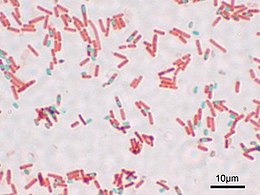This is an old revision of this page, as edited by ArneLH (talk | contribs) at 17:26, 4 January 2012 (→Uses). The present address (URL) is a permanent link to this revision, which may differ significantly from the current revision.
Revision as of 17:26, 4 January 2012 by ArneLH (talk | contribs) (→Uses)(diff) ← Previous revision | Latest revision (diff) | Newer revision → (diff)
| |

| |
| Names | |
|---|---|
| IUPAC name 4--N,N-dimethylaniline | |
| Other names Aniline green; Basic green 4; Diamond green B; Victoria green B | |
| Identifiers | |
| CAS Number | |
| 3D model (JSmol) | |
| ChEMBL | |
| ChemSpider | |
| ECHA InfoCard | 100.008.476 |
| PubChem CID | |
| UNII | |
| CompTox Dashboard (EPA) | |
InChI
| |
SMILES
| |
| Properties | |
| Chemical formula | C23H25ClN2 (chloride) |
| Molar mass | 364.911 g/mol (chloride) |
| Except where otherwise noted, data are given for materials in their standard state (at 25 °C , 100 kPa).
| |
Malachite green is an organic compound that is used as a dyestuff and has emerged as a controversial agent in aquaculture. Malachite green is traditionally used as a dye for materials such as silk, leather, and paper. Although called malachite green, the compound is not related to the mineral malachite — the name just comes from the similarity of color.
Structures and properties
Malachite Green is classified in the dyestuff industry as a triarylmethane dye. Formally, Malachite Green refers to the chloride salt Cl, although the term Malachite Green is used loosely and often just refers to the colored cation. The oxalate salt is also marketed. The chloride and oxalate anions have no effect on the color. The intense green color of the cation results from a strong absorption band at 621 nm (extinction coefficient of 10 Mcm).
| Malachite green (first transition) (pH indicator) | ||
| below pH 0.2 | above pH 1.8 | |
| 0.2 | ⇌ | 1.8 |
| Malachite green (second transition) (pH indicator) | ||
| below pH 11.5 | above pH 13.2 | |
| 11.5 | ⇌ | 13.2 |
Malachite green is prepared by the condensation of benzaldehyde and dimethylaniline to give leuco malachite green (LMG):
- C6H5CHO + 2 C6H5N(CH3)2 → C6H5CH(C6H4N(CH3)2)2 + H2O
Second, this colorless leuco compound, a relative of triphenylmethane, is oxidized to the cation that is MG:
- C6H5CH(C6H4N(CH3)2)2 + HCl + 1/2 O2 → Cl + H2O
A typical oxidizing agent is manganese dioxide.

Hydrolysis of MG gives the carbinol form:
- Cl + H2O → C6H5C(OH)(C6H4N(CH3)2)2 + HCl
This alcohol is important because it, not MG, traverses cell membranes. Once inside the cell, it is metabolized into LMG. Only the cation MG is deeply colored, whereas the LMG and carbinol derivatives are not. This difference arises because only the cationic form has extended pi-delocalization, which allows the molecule to absorb visible light.
Uses
Malachite green is traditionally used as a dye. Millions of kilograms of MG and related triarylmethane dyes are produced annually for this purpose.
MG is active against the oomycete Saprolegnia, which infects fish eggs in commercial aquaculture, and other fungi. Furthermore, MG is also used as a parasiticide, parasiticide and antibacterial. It is a very popular treatment against ichthyophthirius in freshwater aquaria. The principal metabolite, LMG, is found in fish treated with malachite green, and this finding is the basis of controversy and government regulation.
Niche uses

Numerous niche applications exploit the intense color of MG. It is used as a biological stain for microscopic analysis of cell biology and tissue samples. In the Gimenez staining method, basic fuchsin stains bacteria red or magenta, and malachite green is used as a blue-green counterstain. Malachite green can also directly stain endospores within cells; here a safranin counterstain is often used. Malachite green can also be used as a saturable absorber in dye lasers, or as a pH indicator between pH 0.2–1.8. However this use is relatively rare. Leuco-malachite green (LMG) is used as a detection method for latent blood in forensic science. Hemoglobin catalyzes the reaction between LMG and hydrogen peroxide, converting the colorless LMG into malachite green. Therefore, the appearance of a green color indicates the presence of blood.
Regulation
In 1992 Canadian authorities determined that eating fish contaminated with malachite green posed a significant health risk. Malachite green was classified a Class II Health Hazard. Due to its low manufacturing cost, malachite green is still used in certain countries with less restrictive laws for non-aquaculture purposes. In 2005, analysts in Hong Kong found traces of malachite green in eels and fish imported from China and Taiwan. In 2006 the United States Food and Drug Administration (FDA) detected malachite green in seafood imported from China, among others, where the substance is also banned for use in aquaculture. In June 2007, the FDA blocked the importation of several varieties of seafood due to continued malachite green contamination. The substance has been banned in the United States since 1983 in food-related applications. It is banned in the UK also.
Aquatic animals metabolize malachite green to its leuco form. Being non-polar, LMG is retained in catfish muscle longer (t1/2 = 10 days) than is MG (t1/2 = 2.8 days).
Toxicity
The LD50 (oral, mouse) is 80 mg/kg. Rats fed malachite green experience “a dose-related increase in liver DNA adducts” along with lung adenomas. Leuco-malachite green causes an “increase in the number and severity of changes”. As leuco-malachite green is the primary metabolite of malachite green and is retained in fish muscle much longer, most intake of malachite green would be in the leuco form. During the experiment, rats were fed up to 543 ppm of leuco-malachite green, an extreme amount compared to the average 5 ppb discovered in fish. After a period of two years, an increase in lung adenomas in male rats was discovered but no incidences of liver tumors. Therefore it could be concluded that malachite green caused carcinogenic symptoms, but a direct link between malachite green and liver tumor was not established.
References
- Adina Raducan, Alexandra Olteanu, Mihaela Puiu, Dumitru Oancea "Influence of surfactants on the fading of malachite green" Central European Journal of Chemistry, 2008, Volume 6, pp 1895-1066 (Print) 1644-3624 (Online). doi:10.2478/s11532-007-0066-0
- Thomas Gessner and Udo Mayer "Triarylmethane and Diarylmethane Dyes" in Ullmann's Encyclopedia of Industrial Chemistry 2002, Wiley-VCH, Weinheim.doi:10.1002/14356007.a27_179
- Srivastava S, Sinha R, Roy D (2004). "Toxicological effects of malachite green". Aquat Toxicol. 66 (3): 319–29. PMID 15129773.
{{cite journal}}: CS1 maint: multiple names: authors list (link) - Protocol 2.18 Leucomalachite Green Presumptive Test for Blood, National Forensic Science Technology Center, July 8, 2010, Retrieved on July 8, 2010.
- Wendy C. Andersen, Sherri B. Turnipseed, and José E. Roybal "Quantitative and Confirmatory Analyses of Malachite Green and Leucomalachite Green Residues in Fish and Shrimp" J. Agric. Food Chem. 2006, volume 54, pp 4517–4523.doi:10.1021/jf0532258 and references therein
- Chinese fish crisis shows seafood safety challenges, USA Today, 7/1/2007
- Veterinary Residues Committee. Annual Report on Surveillance for Veterinary Residues in Food in the UK for 2001, 2002, and 2003. http://www.vmd.defra.gov.uk/vrc/Reports/annual.htm.
- S.J. Culp; et al. (2002). "Mutagenicity and carcinogenicity in relation to DNA adduct formation in rats fed leucomalachite green". Mutation Research. 506–507: 55–63. doi:10.1016/S0027-5107(02)00152-5. PMID 12351145.
{{cite journal}}: Explicit use of et al. in:|author=(help)
Further reading
- Bongsup P. Cho; et al. (2003). "Synthesis and Characterization of N-Demethylated Metabolites of Malachite Green and Leucomalachite Green". Chem. Res. Toxicol. 16 (3): 285–294. doi:10.1021/tx0256679. PMID 12641428.
{{cite journal}}: Explicit use of et al. in:|author=(help) - S. M. Plakas, K. R. El Said, G. R. Stehly, W. H. Gingerich and J. H. Allen (1996). "Uptake, tissue distribution, and metabolism of malachite green in the channel catfish (Ictalurus punctatus)". Can. J. Fish. Aquat. Sci. 53 (6): 1427–1433. doi:10.1139/cjfas-53-6-1427.
{{cite journal}}: CS1 maint: multiple names: authors list (link) - Schoettger, 1970; Smith and Heath, 1979; Gluth and Hanke, 1983. Bills et al. (1977)
- Steven C. DeFina, Thorsten Dieckmann (2002). "Synthesis of selectively N- or C-labelled malachite green". Journal of Labelled Compounds and Radiopharmaceuticals. 45 (3): 241. doi:10.1002/jlcr.554.
External links
- U.S. National Institutes of Health
- University of Guelph
- U.S. Food and Drug Administration
- U.K. Department of Health
- Malachite green - endospore staining technique (video)